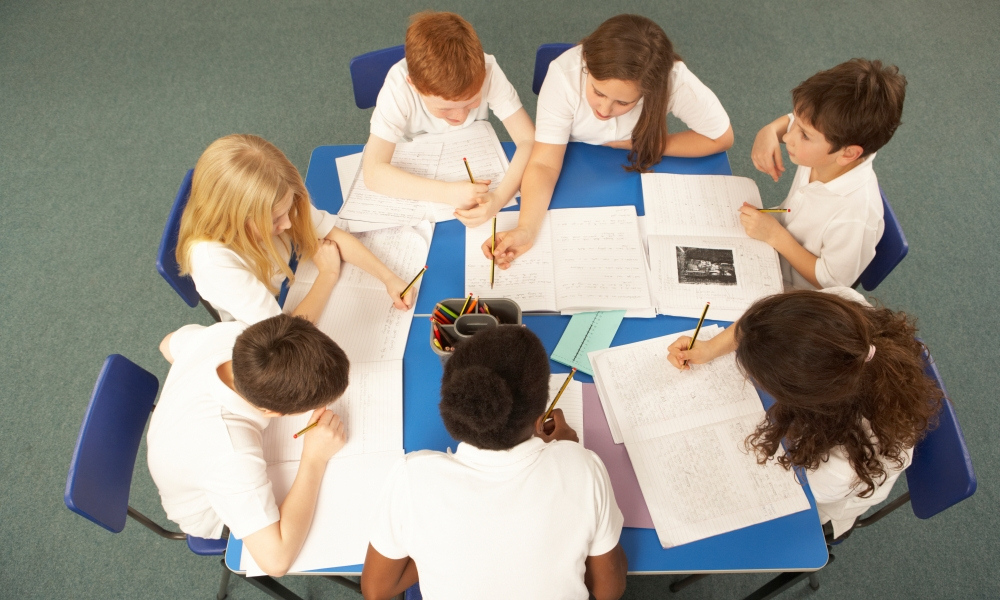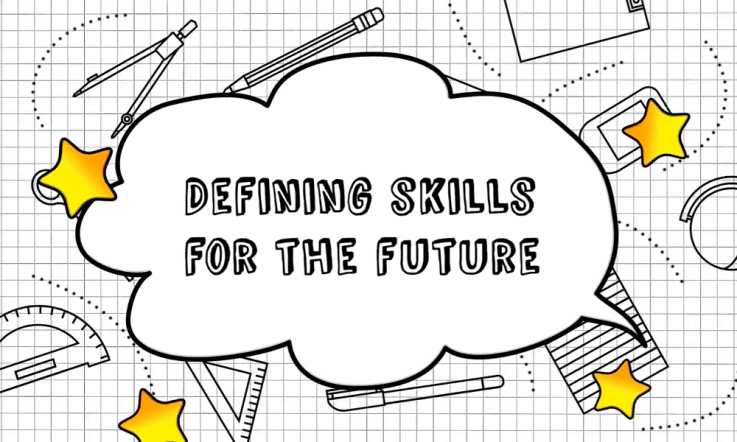There is growing consensus that 21st Century skills, or general capabilities as they are called in Australia, need to be cultivated to help learners succeed in a modern society based on knowledge and innovation.
Development of skills is critical for education systems to produce holistically developed citizens who can learn most effectively in schools and engage in the workplace and with each other. Utilising new ways of working, new ways of living, and new ways of learning is reliant on shifts in assessment, curriculum, and pedagogy to accommodate those changes.
A new set of resources developed by experts at the Australian Council for Educational Research (ACER) aims to provide an evidence-based approach to skills development. ACER's approach to skill development is underpinned by the identification of three evident needs: understanding development, monitoring growth, and ensuring alignment between curriculum, assessment, and pedagogy.
Through a combination of skill development frameworks, levels of skill development, and curriculum-orientated assessment and teaching tools, ACER aims to equip teachers to measure and monitor the skills in their classroom, and better develop these skills in their students.
Critical thinking, creative thinking and collaboration
At the centre of the approach is understanding the skills and how they develop. The first set of skills investigated were critical thinking, creative thinking, and collaboration. Proficiency in these skills is highly valued within educational and professional settings. The degree to which they are defined, taught and assessed, however, is not well documented. While frameworks and definitions for these skills are commonplace, these often lack sufficient detail to understand how these manifest as observable behaviours in the classroom, and there is a distinct lack of evidence-based research.
To address this need, ACER has developed a set of skill development frameworks that provide detailed descriptions of skills as per their associated strands and aspects. The frameworks for critical thinking, creative thinking and collaboration are publicly available.
Rather than ‘reinventing the wheel' to provide alternative definitions than what already exists, ‘the wheel' has been reorientated to provide detailed descriptions of the skills as specifically situated in an education context, as goal orientated endeavours, as operationalised in the classroom, and perhaps most importantly – as behaviours we can identify and monitor in our students.
The connection between conceptualisation of the skill, and the behaviour demonstrated by the student, is critical for teachers (and students and parents) in understanding the skills and how they can be elicited and enhanced. The definitions in the skill development frameworks provide a model for adopting consistent terminology within and across schools – of critical importance moving this work forward.
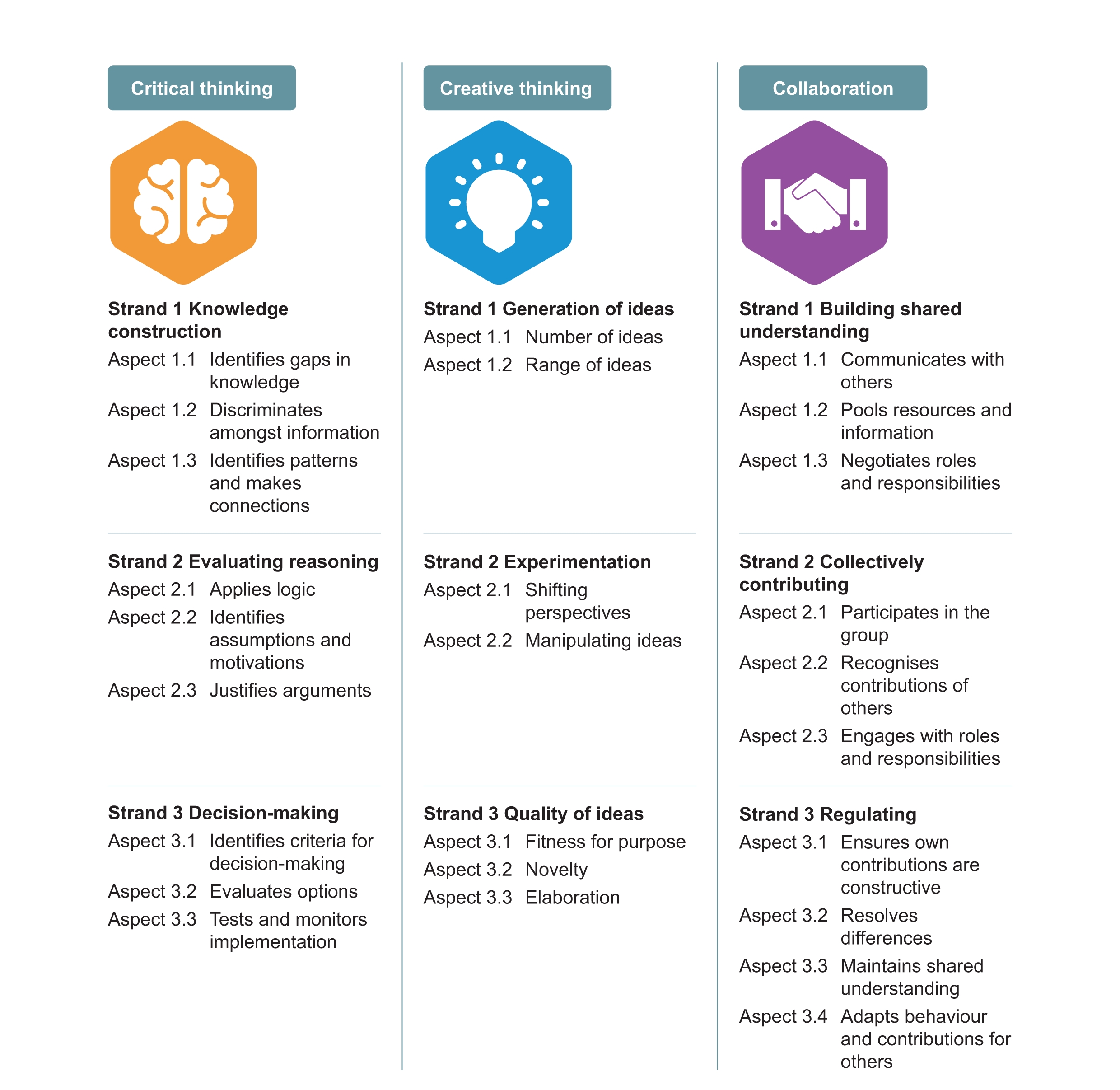
Summary of ACER's skill development frameworks for critical thinking, creative thinking and collaboration.
Growth in skill development
To address the second need, monitoring growth, skills are defined with a growth perspective. For each of the selected skills, levels of skill development are used to describe how growth can be demonstrated, and how students move from early, to more advanced application and understandings. These levels of skill development focus on assessing and monitoring growth over time, and are underpinned by an understanding that students of the same age and in the same year of school can be at very different points in their learning and development. Therefore, they are not linked to specific years of schooling.
While progress can be described in a general way – what a highly proficient critical thinker demonstrates compared to a less proficient critical thinker, for example – the application of the skill by an individual is still dependent on the specific learning area. Levels of skill development can support understanding of the skills and how they develop. They can also support teachers to identify gaps in a learning area, where some students may require further assistance.
The full skill development levels for critical thinking, creative thinking, and collaboration are presented in the respective framework documents. An excerpt from the levels of skill development for collaboration is shown below.
The skills are structured into strands and their associated aspects. Labelling of specific aspects within the levels allows educators to identify and monitor student progress within and across each of the aspects. Teaching, measuring, and monitoring specific aspects, rather than an entire skill, is a more manageable and sustainable approach.
Instead of trying to teach students how to collaborate, the focus instead is on teaching students how to resolve differences (aspect 3.2) or communicate with others in a group (aspect 1.1). Over time, gradually embedding the aspects will eventually lead to good representation of whole skills.
By breaking the skills down into these respective ‘bite-size chunks' not only are teachers getting to grips with their understanding of the skills, students are too. In understanding the aspects that contribute to a skill, students can build a metacognitive understanding of their own development. They can understand what it means to be a good critical thinker, creative thinker or collaborator and reflect on their own ability to apply the skills in any given learning area.
To ensure an evidence-based approach, these levels have been, and will continue to be, validated and corroborated with assessment data.
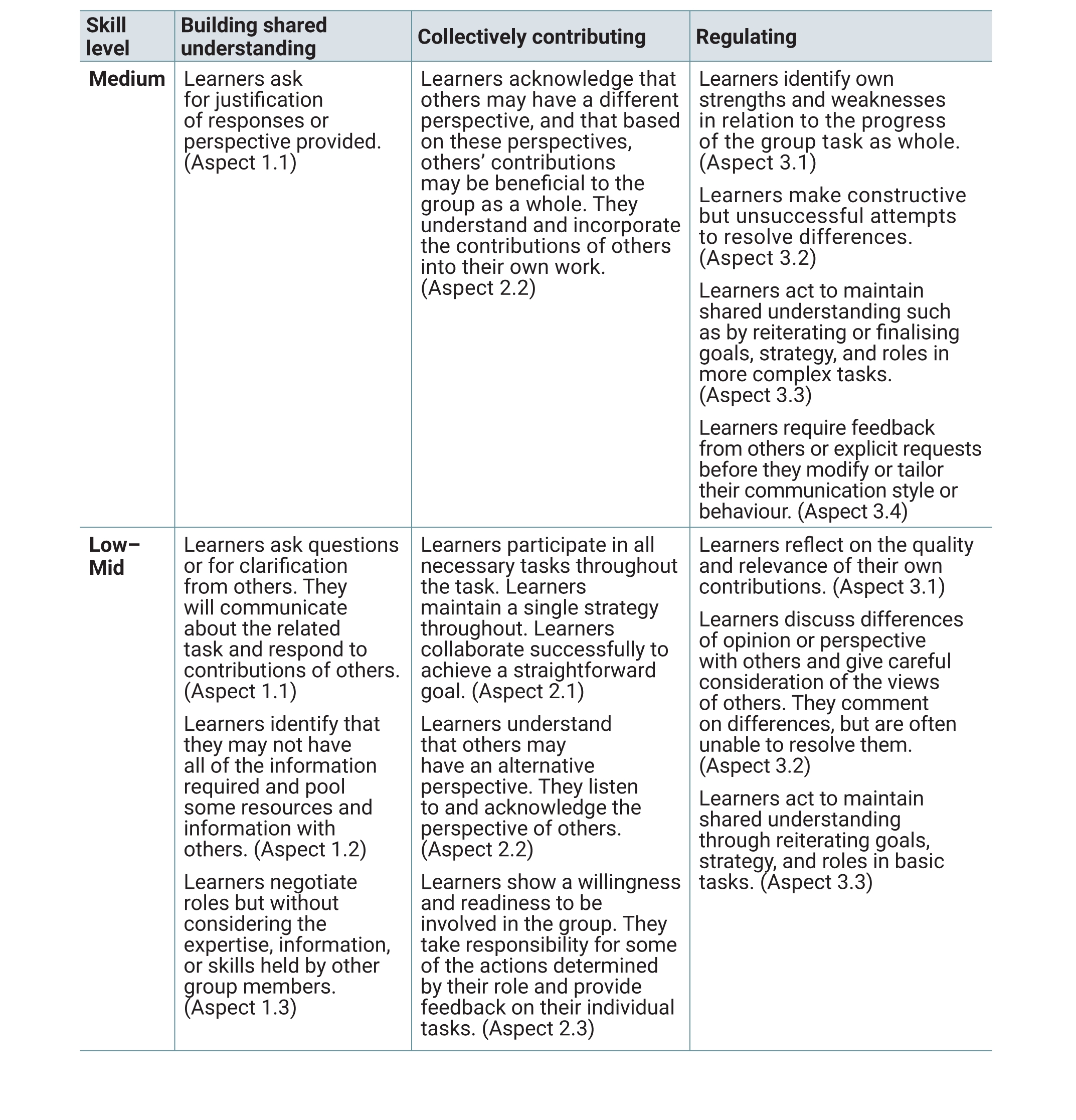
Excerpt from the levels of the Skill Development Framework for Collaboration (Scoular et al., 2020).
Aligning curriculum, assessment and pedagogy
To address the third need, ensuring alignment between curriculum, assessment, and pedagogy, resources have been developed so skills can be embedded within expected learning outcomes, assessments measures, and teaching strategies. Curriculum, assessment and pedagogy should be strongly linked. An aligned approach would ideally integrate both skills development and knowledge of learning areas into learning outcomes.
Curriculum sets out what those learning outcomes are, and provides a framework for identifying where and what skills are presented in different learning areas. Assessment of skills provides an understanding of where students are at in their development, how they progress over time, and whether they achieve those specific learning outcomes. Pedagogical strategies provide the means for skills to be taught within existing learning areas to develop those learning outcomes.
The excerpt below presents an example of how this can be applied in practice at school and classroom level. Again, educators can focus first on the aspects with a view to covering a wider representation of the skill as their understanding builds. For these specific examples below, assessment criteria are from the skill development levels in the ACER frameworks, and learning outcomes are taken from the Australian Curriculum: General Capabilities.
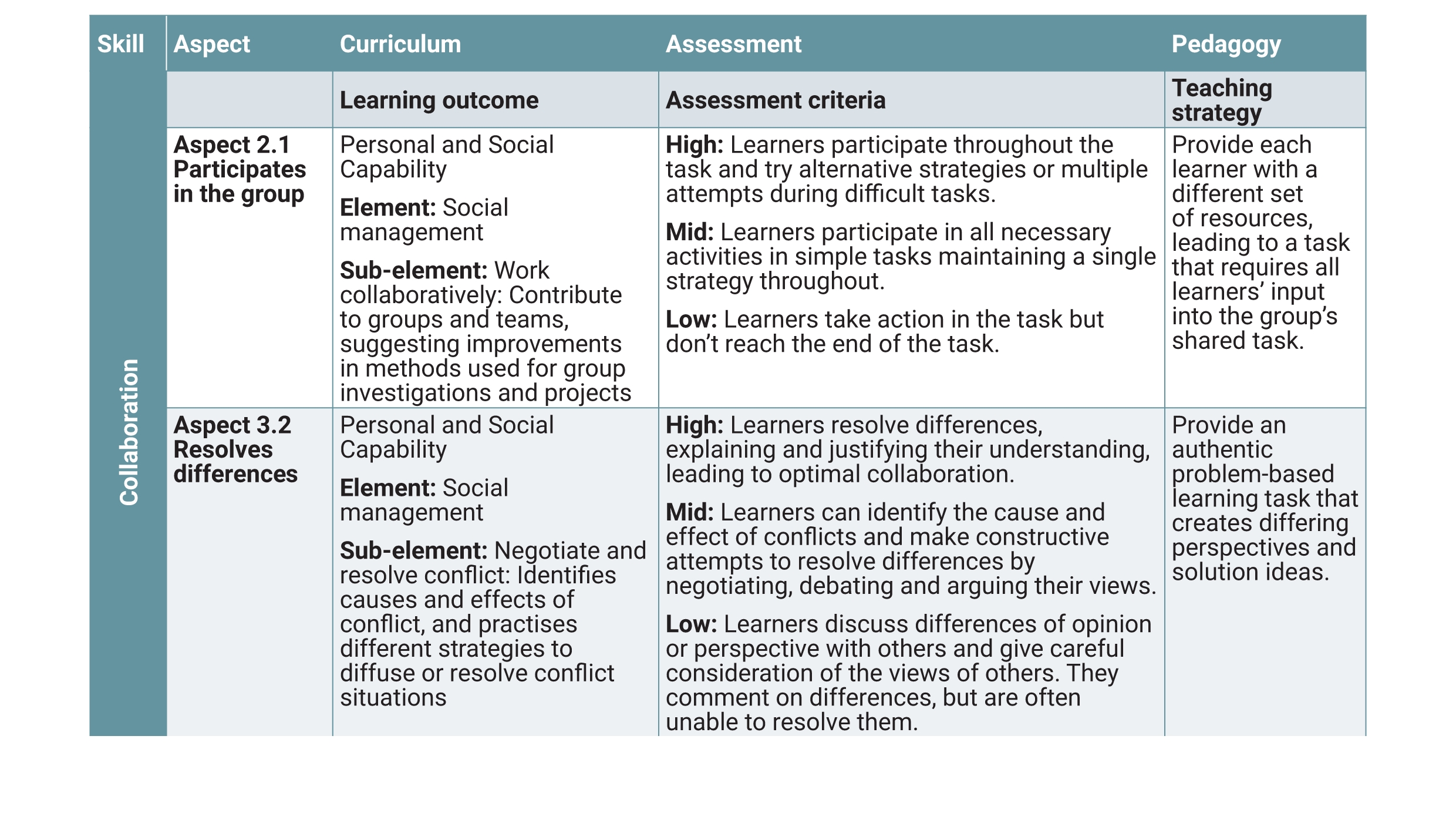
Table 1: Examples of aspect application within curriculum, assessment, and pedagogy.
The research team at ACER hope that this work can contribute to the enormous task of embedding skills development into curriculum, assessment, and teaching practices. ACER continues to trial the resources in schools and has multiple initiatives in which educators can engage with this research. A series of masterclasses have been developed (now available for online delivery) and there is also a General Capabilities Research Community with a quarterly newsletter.
The full project report – Assessment of General Capabilities: Skills for the 21st-century learner, by Claire Scoular, Dara Ramalingam, Daniel Duckworth, and Jonathan Heard – is available from the ACER Repository. To find out more, join the community or email Dr Claire Scoular via claire.scoular@acer.org
References
Scoular, C., Ramalingam, D., Duckworth, D., & Heard, J. (2020). Assessment of General Capabilities: Skills for the 21st-century learner. Final report. Australian Council for Educational Research. https://research.acer.edu.au/ar_misc/47
How much focus does your school give the general capabilities? Do you have existing teaching tools and resources?
Think about your own classroom. How do you measure student success with collaboration, creative thinking and critical thinking? Do students understand the skills and how they can progress?
